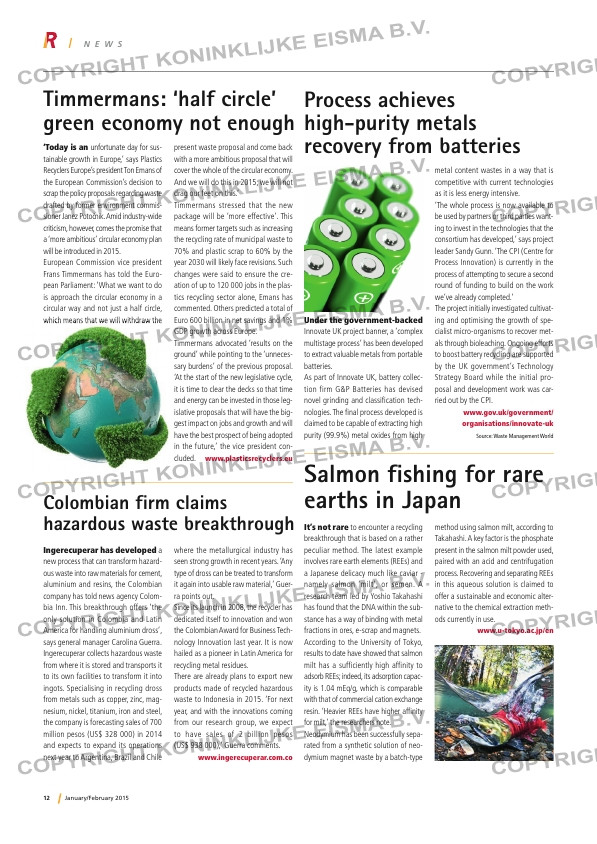Page 12 from: January / February 2015

12 January/February 2015
N E W S
Process achieves
high-purity metals
recovery from batteries
Under the government-backed
Innovate UK project banner, a ‘complex
multistage process’ has been developed
to extract valuable metals from portable
batteries.
As part of Innovate UK, battery collec-
tion firm G&P Batteries has devised
novel grinding and classifi cation tech-
nologies. The fi nal process developed is
claimed to be capable of extracting high
purity (99.9%) metal oxides from high
metal content wastes in a way that is
competitive with current technologies
as it is less energy intensive.
‘The whole process is now available to
be used by partners or third parties want-
ing to invest in the technologies that the
consortium has developed,’ says project
leader Sandy Gunn. ‘The CPI (Centre for
Process Innovation) is currently in the
process of attempting to secure a second
round of funding to build on the work
we’ve already completed.’
The project initially investigated cultivat-
ing and optimising the growth of spe-
cialist micro-organisms to recover met-
als through bioleaching. Ongoing efforts
to boost battery recycling are supported
by the UK government’s Technology
Strategy Board while the initial pro-
posal and development work was car-
ried out by the CPI.
www.gov.uk/government/
organisations/innovate-uk
Source: Waste Management World
It’s not rare to encounter a recycling
breakthrough that is based on a rather
peculiar method. The latest example
involves rare earth elements (REEs) and
a Japanese delicacy much like caviar –
namely salmon ‘milt’, or semen. A
research team led by Yoshio Takahashi
has found that the DNA within the sub-
stance has a way of binding with metal
fractions in ores, e-scrap and magnets.
According to the University of Tokyo,
results to date have showed that salmon
milt has a sufficiently high affinity to
adsorb REEs; indeed, its adsorption capac-
ity is 1.04 mEq/g, which is comparable
with that of commercial cation exchange
resin. ‘Heavier REEs have higher affi nity
for milt,’ the researchers note.
Neodymium has been successfully sepa-
rated from a synthetic solution of neo-
dymium magnet waste by a batch-type
method using salmon milt, according to
Takahashi. A key factor is the phosphate
present in the salmon milt powder used,
paired with an acid and centrifugation
process. Recovering and separating REEs
in this aqueous solution is claimed to
offer a sustainable and economic alter-
native to the chemical extraction meth-
ods currently in use.
www.u-tokyo.ac.jp/en
Salmon fishing for rare
earths in Japan
‘Today is an unfortunate day for sus-
tainable growth in Europe,’ says Plastics
Recyclers Europe’s president Ton Emans of
the European Commission’s decision to
scrap the policy proposals regarding waste
drafted by former environment commis-
sioner Janez Potočnik. Amid industry-wide
criticism, however, comes the promise that
a ‘more ambitious’ circular economy plan
will be introduced in 2015.
European Commission vice president
Frans Timmermans has told the Euro-
pean Parliament: ‘What we want to do
is approach the circular economy in a
circular way and not just a half circle,
which means that we will withdraw the
present waste proposal and come back
with a more ambitious proposal that will
cover the whole of the circular economy.
And we will do this in 2015; we will not
drag our feet on this.’
Timmermans stressed that the new
package will be ‘more effective’. This
means former targets such as increasing
the recycling rate of municipal waste to
70% and plastic scrap to 60% by the
year 2030 will likely face revisions. Such
changes were said to ensure the cre-
ation of up to 120 000 jobs in the plas-
tics recycling sector alone, Emans has
commented. Others predicted a total of
Euro 600 billion in net savings and 1%
GDP growth across Europe.
Timmermans advocated ‘results on the
ground’ while pointing to the ‘unneces-
sary burdens’ of the previous proposal.
‘At the start of the new legislative cycle,
it is time to clear the decks so that time
and energy can be invested in those leg-
islative proposals that will have the big-
gest impact on jobs and growth and will
have the best prospect of being adopted
in the future,’ the vice president con-
cluded. www.plasticsrecyclers.eu
Timmermans: ‘half circle’
green economy not enough
Ingerecuperar has developed a
new process that can transform hazard-
ous waste into raw materials for cement,
aluminium and resins, the Colombian
company has told news agency Colom-
bia Inn. This breakthrough offers ‘the
only solution in Colombia and Latin
America for handling aluminium dross’,
says general manager Carolina Guerra.
Ingerecuperar collects hazardous waste
from where it is stored and transports it
to its own facilities to transform it into
ingots. Specialising in recycling dross
from metals such as copper, zinc, mag-
nesium, nickel, titanium, iron and steel,
the company is forecasting sales of 700
million pesos (US$ 328 000) in 2014
and expects to expand its operations
next year to Argentina, Brazil and Chile
where the metallurgical industry has
seen strong growth in recent years. ‘Any
type of dross can be treated to transform
it again into usable raw material,’ Guer-
ra points out.
Since its launch in 2008, the recycler has
dedicated itself to innovation and won
the Colombian Award for Business Tech-
nology Innovation last year. It is now
hailed as a pioneer in Latin America for
recycling metal residues.
There are already plans to export new
products made of recycled hazardous
waste to Indonesia in 2015. ‘For next
year, and with the innovations coming
from our research group, we expect
to have sales of 2 billion pesos
(US$ 938 000),’ Guerra comments.
www.ingerecuperar.com.co
Colombian firm claims
hazardous waste breakthrough
RI1_NEWS.indd 12 21-01-15 15:30



